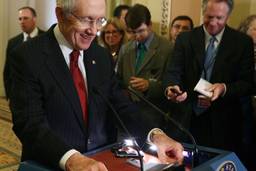
It’s not workers’ fault
State governors across the nation, led by newly elected right-wing Republicans (with several Democratic governors in tow), are whipping up anti-union sentiment by declaring that public workers and their unions are the cause of state budget deficits. They argue that various labor costs are driving up their deficits, and that the lead cause of those labor costs is overly generous increases public employee pension benefits.
But increases in public employee pension benefits are not the cause of the states’ budget crises. There are, indeed, serious pension funding gaps in many states’ public pension plans. But a close investigation of these gaps clearly shows that they do not exist because of states’ granting public employees exorbitant pension benefits.
The real reasons behind the pension funding gap are several. First, the current ‘jobless recovery’ since the 2007-09 recession has reduced contributions to pension fund balances. Current estimates are that it will take 84-96 months, or 7 to 8 years, for job creation to recover to 2007 levels. That means a projected larger pension gap.
But there’s an even greater reason why pension funds have ended up short of income today. It’s the practice of ‘contribution holidays’; that is, pension managers refusing to put the necessary contributions into the funds — a practice in the public sector that has been going on since the mid-1990s and even before that in the private sector.
Contribution holidays in turn were made possible by fund managers employing fraudulent actuarial assumptions about rates of return on fund investments and, secondly, by assuming they would hire large numbers of younger workers when, in fact, that hiring never occurred.
Both gimmicks allow a pension fund to appear adequately funded when in fact it isn’t. They permit fund managers to maintain that the pension has more income and fewer liabilities than it in fact actually has.
The result of contribution holidays and fraudulent actuarial assumptions in the private sector contributed significantly to the collapse of many private pension funds since the 1980s and their replacement with 401k pension contribution plans. What’s starting in the public sector today is merely a repeat of what happened already in the private sector. The goal, once again, is to replace real defined benefit pensions of public workers with nearly worthless 401k plans. What CEOs have been doing in the private sector for three decades, governors are now attempting to do as well.
In the 1980s, there were more than 100,000 defined benefit pension plans in the private sector. Today there are around 28,000. The rest were dissolved or converted to 401k plans or hybrid versions called ‘cash balance plans.’ That is, they were in effect transformed into 401ks and thus ‘privatized.’
The typical conversion resulted in a payoff to employees to transfer to a 401k that was barely half what they would have received in total benefits from their prior defined benefit pension. Today the average balance in a 401k is about $18,000. That’s all to fund an entire retirement period! The governors now want to do the same, to complete the shift to 401ks and privatization of the pensions in the public sector much like that already achieved in the private sector.
Fund managers’ holidays
But beyond the recession and weak job creation, contribution holidays and actuarial fraud, there are additional causes of under-funded public pensions.
The pension funding gap has also been magnified several fold since 2006 as a consequence of public employee pension fund managers’ gambling on risky speculative investments. Prior to 2006 and the passage of the so-called Pension Protection Act, public pension fund managers weren’t allowed to partner with hedge funds and other high-risk financial institutions in high-risk investments.
Since that legislation was passed, it has become a widespread and common practice. After the Pension Act of 2006, pension funds were permitted to make loans to hedge funds and private equity firms, as well to plunge directly themselves into speculating in subprime mortgages and financial derivatives of all kinds. The 2006 Pension Act also permitted still further ‘contribution holidays’.
The result has been that since 2006 all pension funds have incurred great losses as a consequence speculative investing. These losses have added significantly to the pension funding gap in the public sector. It is estimated that public pension funds lost around 25%-30% of their total asset value in 2008-2010 as a result of their foray after 2006 into speculative investing in risky assets like subprimes, derivatives, foreign exchange, and the like.
Still, most pension funds are considered adequately funded and are thus AAA quality if they are 85% funded. A loss of 30% means a funding drop to around 50% funded, as is the case of some of the ‘worst’ funded state pensions like Illinois’ state pension fund. But a funding fall of 30% is, on average, about the funding gap attributable to the recent recession and speculative excesses of fund managers.
Is Illinois’ ‘worst case’ funding gap therefore solely the cause of these non-employee factors? It appears so. If Illinois is typical, then it may be that much of the current funding gap is due to investment losses — not due to public employees pension benefit hikes.
Still another possible cause is escalating healthcare costs. It is a well known fact that federal tax law allows businesses to take money from their pension funds to cover costs in their health benefit plans. While states don’t pay taxes to the federal government, could the same diversion of funds in the public sector explain part of the pension funding gap? It would at least warrant an investigation.
Local government (city) employees pensions were especially hard hit by investments in over the counter derivatives’ interest rate swaps, which banks and other financial institutions talked them into in the run-up to the 2007-08 financial collapse. Their ‘pension funding gap’ consequently grew even further as the pension funds experienced major investment losses.
It is clear, therefore, that the pension funding gap is not the consequence of escalating pension benefits of the average or even bottom 90% of the public employee labor force — but is ultimately caused by the banks, by bad investments by public pension funds managers, by fraudulent accounting practices, by fund managers’ failure to make appropriate contributions to the plans, by recessions, by diversion of funds to cover rising health costs, and by past Congresses and presidents permitting pension funds to gamble and speculate with workers’ retirement incomes.
Therefore a detailed investigation state by state should be undertaken to determine exactly how much these preceding non-employee causes have been responsible for each state’s pension funding gap.
Yet state governors, led by Republicans, are instead driving ahead and placing the blame on public employees and making them pay for the gap in pensions with their wages, jobs, and healthcare benefits. Their goal is converting state defined benefit pension plans to 401k plans and so-called ‘cash balance plans’ that are a preliminary to 401ks.
This conversion will lead in the public sector, as it did in the private before, to eliminating at least half of what public employees would have received in pension benefits. It will lead to the destruction of retirement security among workers in the public sector, just as it had previously among workers in the private.
Why should public workers’ pension benefits be reduced to resolve the funding gap when they aren’t the fundamental cause of it in the first place? Why not make those who created the pension funding gap pay — the hedge funds, banks, insurance companies, and other financial institutions that were responsible for the massive investment losses and the pension fund managers who negligently risked workers’ pensions? Or the politicians who let them?
Making the real perpetrators pay for the funding gap will take time, critics say, and the funding gap is now. True. But why not, in the short run, temporarily stabilize public employee pensions (and thus a good part of states’ budget deficits) by simply making the Federal Reserve provide direct loans to the pension funds at the same cost of 0.25% that the Fed has provided loans to other financial institutions the past two years? After all, pension funds are also financial institutions. And Fed loans won’t add a cent to the federal or state budget deficits as an added plus.
It should not be forgotten that the same Federal Reserve provided $9 trillion to banks during the recent crisis — of which $1 trillion was loaned to foreign non-US banks! If the Fed can loan $1 trillion to foreign bankers and their wealthy bondholders and investors, why can’t it do so to protect the retirement of millions of U.S. workers in the public sector — who are the victims, not the criminals responsible for the public pensions crisis.
Jack Rasmus is the author of ‘EPIC RECESSION: PRELUDE TO GLOBAL DEPRESSION, Pluto Press, May 2010, and the forthcoming ‘OBAMA’s ECONOMY: RECOVERY FOR THE FEW, Pluto Press, 2011. His website is: www.kyklosproductions.com







